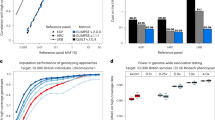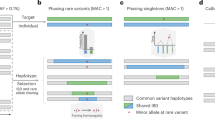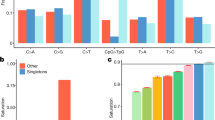Abstract
Genomic data are ubiquitous across disciplines, from agriculture to biodiversity, ecology, evolution and human health. However, these datasets often contain noise or errors and are missing information that can affect the accuracy and reliability of subsequent computational analyses and conclusions. A key step in genomic data analysis is filtering — removing sequencing bases, reads, genetic variants and/or individuals from a dataset — to improve data quality for downstream analyses. Researchers are confronted with a multitude of choices when filtering genomic data; they must choose which filters to apply and select appropriate thresholds. To help usher in the next generation of genomic data filtering, we review and suggest best practices to improve the implementation, reproducibility and reporting standards for filter types and thresholds commonly applied to genomic datasets. We focus mainly on filters for minor allele frequency, missing data per individual or per locus, linkage disequilibrium and Hardy–Weinberg deviations. Using simulated and empirical datasets, we illustrate the large effects of different filtering thresholds on common population genetics statistics, such as Tajima’s D value, population differentiation (FST), nucleotide diversity (π) and effective population size (Ne).
This is a preview of subscription content, access via your institution
Access options
Access Nature and 54 other Nature Portfolio journals
Get Nature+, our best-value online-access subscription
$29.99 / 30 days
cancel any time
Subscribe to this journal
Receive 12 print issues and online access
$189.00 per year
only $15.75 per issue
Buy this article
- Purchase on Springer Link
- Instant access to full article PDF
Prices may be subject to local taxes which are calculated during checkout
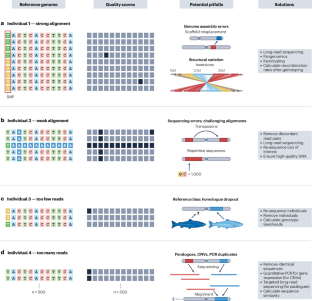
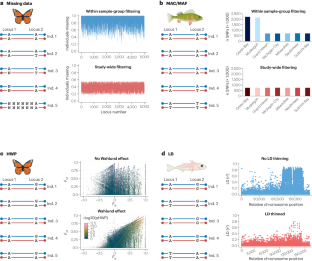
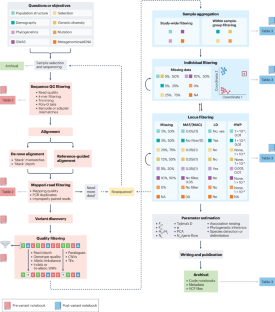
Similar content being viewed by others
Data availability
Information on the empirical and simulated data used for the analyses shown in this review is available in the Supplementary Information.
Code availability
The simulation code is available on GitHub at: https://github.com/ChristieLab/filtering_simulation_paper.
References
Allendorf, F. W., Hohenlohe, P. A. & Luikart, G. Genomics and the future of conservation genetics. Nat. Rev. Genet. 11, 697–709 (2010).
Athanasopoulou, K., Boti, M. A., Adamopoulos, P. G., Skourou, P. C. & Scorilas, A. Third-generation sequencing: the spearhead towards the radical transformation of modern genomics. Life 12, 30 (2022).
Fiedler, P. L. et al. Seizing the moment: the opportunity and relevance of the California Conservation Genomics Project to state and federal conservation policy. J. Hered. 113, 589–596 (2022).
Hu, T., Chitnis, N., Monos, D. & Dinh, A. Next-generation sequencing technologies: an overview. Hum. Immunol. 82, 801–811 (2021).
Pompanon, F., Bonin, A., Bellemain, E. & Taberlet, P. Genotyping errors: causes, consequences and solutions. Nat. Rev. Genet. 6, 847–859 (2005). This review summarizes the sources of many common types of sequencing errors and provides some laboratory and bioinformatic ways to mitigate them.
Stoler, N. & Nekrutenko, A. Sequencing error profiles of Illumina sequencing instruments. NAR Genom. Bioinform. 3, lqab019 (2021).
Fountain, E. D., Pauli, J. N., Reid, B. N., Palsbøll, P. J. & Peery, M. Z. Finding the right coverage: the impact of coverage and sequence quality on single nucleotide polymorphism genotyping error rates. Mol. Ecol. Resour. 16, 966–978 (2016).
O’Leary, S. J., Puritz, J. B., Willis, S. C., Hollenbeck, C. M. & Portnoy, D. S. These aren’t the loci you’re looking for: principles of effective SNP filtering for molecular ecologists. Mol. Ecol. 27, 3193–3206 (2018). This helpful review discusses the effects of missing data, MAC and other filters on genotyping error rates for RADseq data.
Rochette, N. C., Rivera-Colón, A. G. & Catchen, J. M. Stacks 2: analytical methods for paired-end sequencing improve RADseq-based population genomics. Mol. Ecol. 28, 4737–4754 (2019).
Ahrens, C. W. et al. Regarding the F-word: the effects of data filtering on inferred genotype–environment associations. Mol. Ecol. Resour. 21, 1460–1474 (2021).
Andrews, K. R. & Luikart, G. Recent novel approaches for population genomics data analysis. Mol. Ecol. 23, 1661–1667 (2014).
Shafer, A. B. A. et al. Bioinformatic processing of RAD-seq data dramatically impacts downstream population genetic inference. Methods Ecol. Evol. 8, 907–917 (2017). This study demonstrates the effects of different filtering and alignment choices on several downstream statistics and demographic reconstruction in RADseq data.
Larson, W. A., Isermann, D. A. & Feiner, Z. S. Incomplete bioinformatic filtering and inadequate age and growth analysis lead to an incorrect inference of harvested-induced changes. Evol. Appl. 14, 278–289 (2021).
Nazareno, A. G. & Knowles, L. L. There is no ‘rule of thumb’: genomic filter settings for a small plant population to obtain unbiased gene flow estimates. Front. Plant Sci. 12, 677009 (2021). This comprehensive analysis of empirical data demonstrates how missing data and MAF thresholds affect estimates of gene flow.
Sethuraman, A. et al. Continued misuse of multiple testing correction methods in population genetics — a wake-up call? Mol. Ecol. Resour. 19, 23–26 (2019).
Allendorf, F. W. et al. Conservation and the Genomics of Populations (Oxford Univ. Press, 2022).
Gervais, L. et al. RAD-sequencing for estimating genomic relatedness matrix-based heritability in the wild: a case study in roe deer. Mol. Ecol. Resour. 19, 1205–1217 (2019).
Crow, J. F. & Kimura, M. An Introduction to Population Genetics Theory (Scientific Publishers, 2017).
Van Etten, J., Stephens, T. G. & Bhattacharya, D. A k-mer-based approach for phylogenetic classification of taxa in environmental genomic data. Syst. Biol. 72, 1101–1118 (2023).
Todd, E. V., Black, M. A. & Gemmell, N. J. The power and promise of RNA-seq in ecology and evolution. Mol. Ecol. 25, 1224–1241 (2016).
Conesa, A. et al. A survey of best practices for RNA-seq data analysis. Genome Biol. 17, 13 (2016).
Olofsson, D., Preußner, M., Kowar, A., Heyd, F. & Neumann, A. One pipeline to predict them all? On the prediction of alternative splicing from RNA-seq data. Biochem. Biophys. Res. Commun. 653, 31–37 (2023).
Upton, R. N. et al. Design, execution, and interpretation of plant RNA-seq analyses. Front. Plant Sci. 14, 1135455 (2023).
Rehn, J. et al. RaScALL: rapid (Ra) screening (Sc) of RNA-seq data for prognostically significant genomic alterations in acute lymphoblastic leukaemia (ALL). PLOS Genet. 18, e1010300 (2022).
Boshuizen, H. C. & te Beest, D. E. Pitfalls in the statistical analysis of microbiome amplicon sequencing data. Mol. Ecol. Resour. 23, 539–548 (2023).
Combrink, L. et al. Best practice for wildlife gut microbiome research: a comprehensive review of methodology for 16S rRNA gene investigations. Front. Microbiol. 14, 1092216 (2023).
Cheng, Z. et al. Transcriptomic analysis of circulating leukocytes obtained during the recovery from clinical mastitis caused by Escherichia coli in Holstein dairy cows. Animals 12, 2146 (2022).
Yang, L. & Chen, J. Benchmarking differential abundance analysis methods for correlated microbiome sequencing data. Brief. Bioinformatics 24, bbac607 (2023).
Patin, N. V. & Goodwin, K. D. Capturing marine microbiomes and environmental DNA: a field sampling guide. Front. Microbiol. 13, 1026596 (2023).
Ruppert, K. M., Kline, R. J. & Rahman, M. S. Past, present, and future perspectives of environmental DNA (eDNA) metabarcoding: a systematic review in methods, monitoring, and applications of global eDNA. Glob. Ecol. Conserv. 17, e00547 (2019).
Deyneko, I. V. et al. Modeling and cleaning RNA-seq data significantly improve detection of differentially expressed genes. BMC Bioinformatics 23, 488 (2022).
Giusti, A., Malloggi, C., Magagna, G., Filipello, V. & Armani, A. Is the metabarcoding ripe enough to be applied to the authentication of foodstuff of animal origin? A systematic review. Compr. Rev. Food Sci. Food Saf. 23, 1–21 (2024).
da Fonseca, R. R. et al. Next-generation biology: sequencing and data analysis approaches for non-model organisms. Mar. Genomics 30, 3–13 (2016).
Zhao, M. et al. Exploring conflicts in whole genome phylogenetics: a case study within manakins (Aves: Pipridae). Syst. Biol. 72, 161–178 (2023).
Koboldt, D. C. Best practices for variant calling in clinical sequencing. Genome Med 12, 91 (2020).
Giani, A. M., Gallo, G. R., Gianfranceschi, L. & Formenti, G. Long walk to genomics: history and current approaches to genome sequencing and assembly. Comput. Struct. Biotechnol. J. 18, 9–19 (2020).
Kumar, K. R., Cowley, M. J. & Davis, R. L. Next-generation sequencing and emerging technologies. Semin. Thromb. Hemost. 45, 661–673 (2019).
Shendure, J. et al. DNA sequencing at 40: past, present and future. Nature 550, 345–353 (2017).
Lou, R. N., Jacobs, A., Wilder, A. P. & Therkildsen, N. O. A beginner’s guide to low-coverage whole genome sequencing for population genomics. Mol. Ecol. 30, 5966–5993 (2021). This reviews discusses the production and analysis of low-coverage WGS data.
Olson, N. D. et al. Variant calling and benchmarking in an era of complete human genome sequences. Nat. Rev. Genet. 24, 464–483 (2023).
Rochette, N. C. & Catchen, J. M. Deriving genotypes from RAD-seq short-read data using Stacks. Nat. Protoc. 12, 2640–2659 (2017).
Paris, J. R., Stevens, J. R. & Catchen, J. M. Lost in parameter space: a road map for stacks. Methods Ecol. Evol. 8, 1360–1373 (2017).
Ceballos, F. C., Joshi, P. K., Clark, D. W., Ramsay, M. & Wilson, J. F. Runs of homozygosity: windows into population history and trait architecture. Nat. Rev. Genet. 19, 220–234 (2018).
Heller, R. et al. A reference-free approach to analyse RADseq data using standard next generation sequencing toolkits. Mol. Ecol. Resour. 21, 1085–1097 (2021).
Bohling, J. Evaluating the effect of reference genome divergence on the analysis of empirical RADseq datasets. Ecol. Evol. 10, 7585–7601 (2020).
Valiente-Mullor, C. et al. One is not enough: on the effects of reference genome for the mapping and subsequent analyses of short-reads. PLOS Comput. Biol. 17, e1008678 (2021).
Hendricks, S. et al. Recent advances in conservation and population genomics data analysis. Evol. Appl. 11, 1197–1211 (2018).
Vaux, F., Dutoit, L., Fraser, C. I. & Waters, J. M. Genotyping-by-sequencing for biogeography. J. Biogeogr. 50, 262–281 (2023).
Jackson, B. C., Campos, J. L. & Zeng, K. The effects of purifying selection on patterns of genetic differentiation between Drosophila melanogaster populations. Heredity 114, 163–174 (2015).
Luikart, G., England, P. R., Tallmon, D., Jordan, S. & Taberlet, P. The power and promise of population genomics: from genotyping to genome typing. Nat. Rev. Genet. 4, 981–994 (2003).
Benestan, L. et al. Sex matters in massive parallel sequencing: evidence for biases in genetic parameter estimation and investigation of sex determination systems. Mol. Ecol. 26, 6767–6783 (2017).
Yang, Z. et al. Multi-omics provides new insights into the domestication and improvement of dark jute (Corchorus olitorius). Plant J. 112, 812–829 (2022).
Zeng, L. et al. Whole genomes and transcriptomes reveal adaptation and domestication of pistachio. Genome Biol. 20, 79 (2019).
Zhernakova, D. V. et al. Genome-wide sequence analyses of ethnic populations across Russia. Genomics 112, 442–458 (2020).
Langmead, B. & Salzberg, S. L. Fast gapped-read alignment with Bowtie 2. Nat. Methods 9, 357–359 (2012).
Li, H. & Durbin, R. Fast and accurate short read alignment with Burrows–Wheeler transform. Bioinformatics 25, 1754–1760 (2009).
Pfeifer, S. P. From next-generation resequencing reads to a high-quality variant data set. Heredity 118, 111–124 (2017).
Lefouili, M. & Nam, K. The evaluation of BCFtools mpileup and GATK HaplotypeCaller for variant calling in non-human species. Sci. Rep. 12, 11331 (2022).
Chen, N.-C., Solomon, B., Mun, T., Iyer, S. & Langmead, B. Reference flow: reducing reference bias using multiple population genomes. Genome Biol. 22, 8 (2021).
Günther, T. & Nettelblad, C. The presence and impact of reference bias on population genomic studies of prehistoric human populations. PLOS Genet. 15, e1008302 (2019).
Rhie, A. et al. Towards complete and error-free genome assemblies of all vertebrate species. Nature 592, 737–746 (2021).
Ho, S. S., Urban, A. E. & Mills, R. E. Structural variation in the sequencing era. Nat. Rev. Genet. 21, 171–189 (2020).
Singh, A. K. et al. Detecting copy number variation in next generation sequencing data from diagnostic gene panels. BMC Med. Genomics 14, 214 (2021).
Willis, S. C., Hollenbeck, C. M., Puritz, J. B., Gold, J. R. & Portnoy, D. S. Haplotyping RAD loci: an efficient method to filter paralogs and account for physical linkage. Mol. Ecol. Resour. 17, 955–965 (2017).
Ou, S. et al. Benchmarking transposable element annotation methods for creation of a streamlined, comprehensive pipeline. Genome Biol. 20, 275 (2019).
Rochette, N. C. et al. On the causes, consequences, and avoidance of PCR duplicates: towards a theory of library complexity. Mol. Ecol. Resour. 23, 1299–1318 (2023).
Van der Auwera, G. A. & O’Connor, B. D. Genomics in the Cloud: Using Docker, GATK, and WDL in Terra (O’Reilly Media, 2020).
Korneliussen, T. S., Albrechtsen, A. & Nielsen, R. ANGSD: analysis of next generation sequencing data. BMC Bioinformatics 15, 356 (2014).
Eaton, D. A. R. & Overcast, I. ipyrad: interactive assembly and analysis of RADseq datasets. Bioinformatics 36, 2592–2594 (2020).
Layer, R. M., Chiang, C., Quinlan, A. R. & Hall, I. M. LUMPY: a probabilistic framework for structural variant discovery. Genome Biol. 15, R84 (2014).
Danecek, P. et al. Twelve years of SAMtools and BCFtools. Gigascience 10, giab008 (2021).
Mona, S., Benazzo, A., Delrieu-Trottin, E. & Lesturgie, P. Population genetics using low coverage RADseq data in non-model organisms: biases and solutions. Preprint at Authorea https://doi.org/10.22541/au.168252801.19878064/v1 (2023).
Nielsen, R., Korneliussen, T., Albrechtsen, A., Li, Y. & Wang, J. SNP calling, genotype calling, and sample allele frequency estimation from new-generation sequencing data. PLoS ONE 7, e37558 (2012).
Warmuth, V. M. & Ellegren, H. Genotype-free estimation of allele frequencies reduces bias and improves demographic inference from RADseq data. Mol. Ecol. Resour. 19, 586–596 (2019).
Wright, B. et al. From reference genomes to population genomics: comparing three reference-aligned reduced-representation sequencing pipelines in two wildlife species. BMC Genomics 20, 453 (2019).
Huang, H. & Knowles, L. L. Unforeseen consequences of excluding missing data from next-generation sequences: simulation study of RAD sequences. Syst. Biol. 65, 357–365 (2016).
Duntsch, L., Whibley, A., Brekke, P., Ewen, J. G. & Santure, A. W. Genomic data of different resolutions reveal consistent inbreeding estimates but contrasting homozygosity landscapes for the threatened Aotearoa New Zealand hihi. Mol. Ecol. 30, 6006–6020 (2021).
Kardos, M. & Waples, R. S. Low-coverage sequencing and Wahlund effect severely bias estimates of inbreeding, heterozygosity, and effective population size in North American wolves. Mol. Ecol. https://doi.org/10.1111/mec.17415 (2024). This study reports biases that could affect management decisions caused by next-generation sequencing filtering choices, low-coverage data and the sampling strategy.
Schmidt, T. L., Jasper, M.-E., Weeks, A. R. & Hoffmann, A. A. Unbiased population heterozygosity estimates from genome-wide sequence data. Methods Ecol. Evol. 12, 1888–1898 (2021).
Sopniewski, J. & Catullo, R. A. Estimates of heterozygosity from single nucleotide polymorphism markers are context-dependent and often wrong. Mol. Ecol. Resour. 24, e13947 (2024).
Pritchard, J. K., Stephens, M. & Donnelly, P. Inference of population structure using multilocus genotype data. Genetics 155, 945–959 (2000).
Waples, R. S. Testing for Hardy–Weinberg proportions: have we lost the plot? J. Hered. 106, 1–19 (2015).
Gautier, M. et al. The effect of RAD allele dropout on the estimation of genetic variation within and between populations. Mol. Ecol. 22, 3165–3178 (2013).
McKinney, G. J., Waples, R. K., Seeb, L. W. & Seeb, J. E. Paralogs are revealed by proportion of heterozygotes and deviations in read ratios in genotyping-by-sequencing data from natural populations. Mol. Ecol. Resour. 17, 656–669 (2017).
Bitarello, B. D., Brandt, D. Y. C., Meyer, D. & Andrés, A. M. Inferring balancing selection from genome-scale data. Genome Biol. Evol. 15, evad032 (2023).
Pearman, W. S., Urban, L. & Alexander, A. Commonly used Hardy–Weinberg equilibrium filtering schemes impact population structure inferences using RADseq data. Mol. Ecol. Resour. 22, 2599–2613 (2022). This study demonstrates the impact of pooling or splitting sample-groups when applying HWP filters to FST and other population structure inferences.
Linderoth, T. P. Identifying population histories, adaptive genes, and genetic duplication from population-scale next generation sequencing. Genome Res. 20, 291–300 (2018).
Benjamini, Y. & Hochberg, Y. Controlling the false discovery rate: a practical and powerful approach to multiple testing. J. R. Stat. Soc. Ser. B Methodol. 57, 289–300 (1995).
Holm, S. A simple sequentially rejective multiple test procedure. Scand. J. Stat. 6, 65–70 (1979).
Graffelman, J., Jain, D. & Weir, B. A genome-wide study of Hardy–Weinberg equilibrium with next generation sequence data. Hum. Genet. 136, 727–741 (2017).
Larson, W. A. et al. Genotyping by sequencing resolves shallow population structure to inform conservation of Chinook salmon (Oncorhynchus tshawytscha). Evol. Appl. 7, 355–369 (2014).
Waples, R. K., Larson, W. A. & Waples, R. S. Estimating contemporary effective population size in non-model species using linkage disequilibrium across thousands of loci. Heredity 117, 233–240 (2016).
Gattepaille, L. M., Jakobsson, M. & Blum, M. G. Inferring population size changes with sequence and SNP data: lessons from human bottlenecks. Heredity 110, 409–419 (2013).
Tajima, F. Statistical method for testing the neutral mutation hypothesis by DNA polymorphism. Genetics 123, 585 LP–585595 (1989).
Arantes, L. S. et al. Scaling-up RADseq methods for large datasets of non-invasive samples: lessons for library construction and data preprocessing. Mol. Ecol. Resour. https://doi.org/10.1111/1755-0998.13859 (2023).
Cubry, P., Vigouroux, Y. & François, O. The empirical distribution of singletons for geographic samples of DNA sequences. Front. Genet. 8, 139 (2017).
Linck, E. & Battey, C. J. Minor allele frequency thresholds strongly affect population structure inference with genomic data sets. Mol. Ecol. Resour. 19, 639–647 (2019). This study demonstrates how MAF thresholds affect population structure inferences using both simulated and empirical data.
Andersson, B. A., Zhao, W., Haller, B. C., Brännström, Å. & Wang, X.-R. Inference of the distribution of fitness effects of mutations is affected by single nucleotide polymorphism filtering methods, sample size and population structure. Mol. Ecol. Resour. 23, 1589–1603 (2023).
Díaz-Arce, N. & Rodríguez-Ezpeleta, N. Selecting RAD-seq data analysis parameters for population genetics: the more the better? Front. Genet. 10, 533 (2019).
Holsinger, K. E. & Weir, B. S. Genetics in geographically structured populations: defining, estimating and interpreting FST. Nat. Rev. Genet. 10, 639–650 (2009).
Roesti, M., Salzburger, W. & Berner, D. Uninformative polymorphisms bias genome scans for signatures of selection. BMC Evol. Biol. 12, 94 (2012).
Yin, X. et al. Rapid, simultaneous increases in the effective sizes of adaptively divergent yellow perch (Perca flavescens) populations. Preprint at bioRxiv https://doi.org/10.1101/2024.04.21.590447 (2024).
Visscher, P. M. et al. 10 years of GWAS discovery: biology, function, and translation. Am. J. Hum. Genet. 101, 5–22 (2017).
Tennessen, J. A. et al. Evolution and functional impact of rare coding variation from deep sequencing of human exomes. Science 337, 64–69 (2012).
Dementieva, N. V. et al. Assessing the effects of rare alleles and linkage disequilibrium on estimates of genetic diversity in the chicken populations. Animal 15, 100171 (2021).
De Meeûs, T. Revisiting FIS, FST, Wahlund effects, and null alleles. J. Hered. 109, 446–456 (2018).
Levy-Sakin, M. et al. Genome maps across 26 human populations reveal population-specific patterns of structural variation. Nat. Commun. 10, 1025 (2019).
Zhang, H., Yin, L., Wang, M., Yuan, X. & Liu, X. Factors affecting the accuracy of genomic selection for agricultural economic traits in maize, cattle, and pig populations. Front. Genet. 10, 189 (2019).
Anderson, E. C. & Garza, J. C. The power of single-nucleotide polymorphisms for large-scale parentage inference. Genetics 172, 2567–2582 (2006).
Dussault, F. M. & Boulding, E. G. Effect of minor allele frequency on the number of single nucleotide polymorphisms needed for accurate parentage assignment: a methodology illustrated using Atlantic salmon. Aquac. Res. 49, 1368–1372 (2018).
Thompson, E. The estimation of pairwise relationships. Ann. Hum. Genet. 39, 173–188 (1975).
Goubert, C. et al. A beginner’s guide to manual curation of transposable elements. Mob. DNA 13, 7 (2022).
Storer, J. M., Hubley, R., Rosen, J. & Smit, A. F. A. Curation guidelines for de novo generated transposable element families. Curr. Protoc. 1, e154 (2021).
Hemstrom, W. B., Freedman, M. G., Zalucki, M. P., Ramírez, S. R. & Miller, M. R. Population genetics of a recent range expansion and subsequent loss of migration in monarch butterflies. Mol. Ecol. 31, 4544–4557 (2022).
Escoda, L., González-Esteban, J., Gómez, A. & Castresana, J. Using relatedness networks to infer contemporary dispersal: application to the endangered mammal Galemys pyrenaicus. Mol. Ecol. 26, 3343–3357 (2017).
Brown, A. V. et al. Ten quick tips for sharing open genomic data. PLOS Comput. Biol. 14, e1006472 (2018).
Zhang, D. et al. PhyloSuite: an integrated and scalable desktop platform for streamlined molecular sequence data management and evolutionary phylogenetics studies. Mol. Ecol. Resour. 20, 348–355 (2020).
Tanjo, T., Kawai, Y., Tokunaga, K., Ogasawara, O. & Nagasaki, M. Practical guide for managing large-scale human genome data in research. J. Hum. Genet. 66, 39–52 (2021).
Del Fabbro, C., Scalabrin, S., Morgante, M. & Giorgi, F. M. An extensive evaluation of read trimming effects on illumina NGS data analysis. PLoS ONE 8, e85024 (2013).
Yang, S.-F., Lu, C.-W., Yao, C.-T. & Hung, C.-M. To trim or not to trim: effects of read trimming on the de novo genome assembly of a widespread East Asian passerine, the rufous-capped babbler (Cyanoderma ruficeps Blyth). Genes 10, 737 (2019).
Hotaling, S. et al. Demographic modelling reveals a history of divergence with gene flow for a glacially tied stonefly in a changing post-Pleistocene landscape. J. Biogeogr. 45, 304–317 (2018).
Cumer, T. et al. Double-digest RAD-sequencing: do pre- and post-sequencing protocol parameters impact biological results? Mol. Genet. Genomics 296, 457–471 (2021).
Mastretta-Yanes, A. et al. Restriction site-associated DNA sequencing, genotyping error estimation and de novo assembly optimization for population genetic inference. Mol. Ecol. Resour. 15, 28–41 (2015).
Ebbert, M. T. W. et al. Evaluating the necessity of PCR duplicate removal from next-generation sequencing data and a comparison of approaches. BMC Bioinformatics 17, 239 (2016).
Euclide, P. T. et al. Attack of the PCR clones: rates of clonality have little effect on RAD-seq genotype calls. Mol. Ecol. Resour. 20, 66–78 (2020).
Flanagan, S. P. & Jones, A. G. Substantial differences in bias between single-digest and double-digest RAD-seq libraries: a case study. Mol. Ecol. Resour. 18, 264–280 (2018).
Martins, F. B. et al. A semi-automated SNP-based approach for contaminant identification in biparental polyploid populations of tropical forage grasses. Front. Plant Sci. 12, 737919 (2021).
Deo, T. G. et al. High-resolution linkage map with allele dosage allows the identification of regions governing complex traits and apospory in guinea grass (Megathyrsus maximus). Front. Plant Sci. 11, 15 (2020).
Zhang, F. et al. Ancestry-agnostic estimation of DNA sample contamination from sequence reads. Genome Res. 30, 185–194 (2020).
Christie, M. R., Marine, M. L., Fox, S. E., French, R. A. & Blouin, M. S. A single generation of domestication heritably alters the expression of hundreds of genes. Nat. Commun. 7, 10676 (2016).
Lou, R. N. & Therkildsen, N. O. Batch effects in population genomic studies with low-coverage whole genome sequencing data: causes, detection and mitigation. Mol. Ecol. Resour. 22, 1678–1692 (2022).
Danecek, P. et al. The variant call format and VCFtools. Bioinformatics 27, 2156–2158 (2011).
Mirchandani, C. D. et al. A fast, reproducible, high-throughput variant calling workflow for population genomics. Mol. Biol. Evol. 41, msad270 (2024).
Peñalba, J. V., Peters, J. L. & Joseph, L. Sustained plumage divergence despite weak genomic differentiation and broad sympatry in sister species of Australian woodswallows (Artamus spp.). Mol. Ecol. 31, 5060–5073 (2022).
Thompson, N. F. et al. A complex phenotype in salmon controlled by a simple change in migratory timing. Science 370, 609–613 (2020).
Howe, K. et al. Significantly improving the quality of genome assemblies through curation. Gigascience 10, giaa153 (2021).
Nurk, S. et al. The complete sequence of a human genome. Science 376, 44–53 (2022).
Michael, T. P. & VanBuren, R. Building near-complete plant genomes. Genome Stud. Mol. Genet. 54, 26–33 (2020).
Tettelin, H. & Medini, D. The Pangenome: Diversity, Dynamics and Evolution of Genomes (Springer, 2020).
Wang, T. et al. The Human Pangenome Project: a global resource to map genomic diversity. Nature 604, 437–446 (2022).
Hemstrom, W. Thirty-Four Kilometers and Fifteen Years: Rapid Adaptation at a Novel Chromosomal Inversion in Recently Introduced Deschutes River Three-Spined Stickleback. Thesis, Oregon State Univ. (2016).
Halvorsen, S., Korslund, L., Mattingsdal, M. & Slettan, A. Estimating number of European eel (Anguilla anguilla) individuals using environmental DNA and haplotype count in small rivers. Ecol. Evol. 13, e9785 (2023).
Whitlock, M. C. & Lotterhos, K. E. Reliable detection of loci responsible for local adaptation: inference of a null model through trimming the distribution of FST. Am. Nat. 186, S24–S36 (2015).
vonHoldt, B. M. et al. Demographic history shapes North American gray wolf genomic diversity and informs species’ conservation. Mol. Ecol. 33, e17231 (2024).
Alonso-Blanco, C. et al. 1,135 genomes reveal the global pattern of polymorphism in Arabidopsis thaliana. Cell 166, 481–491 (2016).
Maruki, T., Ye, Z. & Lynch, M. Evolutionary genomics of a subdivided species. Mol. Biol. Evol. 39, msac152 (2022).
Kessler, C., Wootton, E. & Shafer, A. B. A. Speciation without gene-flow in hybridizing deer. Mol. Ecol. 32, 1117–1132 (2023).
Martchenko, D. & Shafer, A. B. A. Contrasting whole-genome and reduced representation sequencing for population demographic and adaptive inference: an alpine mammal case study. Heredity 131, 273–281 (2023).
Lowy-Gallego, E. et al. Variant calling on the GRCh38 assembly with the data from phase three of the 1000 Genomes Project. Wellcome Open Res. 4, 50 (2019).
Schweizer, R. M. et al. Broad concordance in the spatial distribution of adaptive and neutral genetic variation across an elevational gradient in deer mice. Mol. Biol. Evol. 38, 4286–4300 (2021).
Kardos, M. et al. Inbreeding depression explains killer whale population dynamics. Nat. Ecol. Evol. 7, 675–686 (2023).
Malison, R. L. et al. Landscape connectivity and genetic structure in a mainstem and a tributary stonefly (Plecoptera) species using a novel reference genome. J. Hered. 113, 453–471 (2022).
Robinson, J. M. et al. Traditional ecological knowledge in restoration ecology: a call to listen deeply, to engage with, and respect Indigenous voices. Restor. Ecol. 29, e13381 (2021).
Lynch, M. The Origins of Genome Architecture (Sinauer Associates, 2007).
Lynch, M. & O’Hely, M. Captive breeding and the genetic fitness of natural populations. Conserv. Genet. 2, 363–378 (2001).
Acknowledgements
The authors thank E. Anderson, A. Leaché, M. Kardos and the reviewers for their helpful comments that greatly improved this manuscript. The authors also thank M. Exposito-Alonso and the 1001 Genomes Consortium, the 1000 Genomes Project, B. Hand, M. Freedman, M. Kardos, C. Kessler, M. Lynch, R. Malison, D. Martchenko, M. Miller, R. Schweizer, A.B.A. Shafer and X. Yin for allowing their datasets to be reviewed and re-filtered. M.R.C. was funded, in part, by NSF DEB-1856710 and OCE-1924505. G.L. was funded, in part, by NSF-DOB-M66230.
Author information
Authors and Affiliations
Contributions
All authors conceptualized, wrote and edited the manuscript. W.H. and J.A.G. conducted the simulations and analyses in Box 2.
Corresponding authors
Ethics declarations
Competing interests
The authors declare no competing interests.
Peer review
Peer review information
Nature Reviews Genetics thanks Mark Ravinet and the other, anonymous, reviewer(s) for their contribution to the peer review of this work.
Additional information
Publisher’s note Springer Nature remains neutral with regard to jurisdictional claims in published maps and institutional affiliations.
Related links
DNA DataBank of Japan Sequence Read Archive: https://www.ddbj.nig.ac.jp/dra/index-e.html
European Variation Archive: https://www.ebi.ac.uk/eva/
GATK: https://gatk.broadinstitute.org/hc/en-us
NCBI Short-Read Archive: https://www.ncbi.nlm.nih.gov/sra
Supplementary information
Glossary
- Alignment
-
The mapping of sequencing reads and/or contigs to either each other (pairwise/multiple alignment) or to a reference. Alignments can vary in the strength of the evidence that supports them. Most alignment tools will return map quality (mapQ) scores, the derivation and meaning of which varies by program. Filtering thresholds based on this score must consider the specific aligner used.
- Base quality score
-
The value in a logarithmic, Phred scale given to each base on a sequencing read that indicates a quantitative degree of confidence in the nucleotide called from the sequencing instrument.
- Contigs
-
Contiguous sequences of DNA assembled from many overlapping sequence reads, representing a fragment of a chromosome.
- De novo assembly
-
The reference-free alignment of sequencing reads into overlapping stacks or contigs for subsequent use in variant discovery and genotyping.
- F IS
-
A measure of inbreeding; the degree of subpopulation divergence from Hardy–Weinberg proportions — the correlation between alleles at specific loci within individuals relative to the subpopulation.
- F ST
-
A measure of population differentiation; the proportion of the total genetic variance due to differences in allele frequencies between subpopulations.
- Genetic variants
-
Differences in DNA sequence compared with a reference sequence or other individuals within a population. The term includes short variants (single-nucleotide polymorphisms (SNPs) or insertions and deletions) and structural variants (chromosomal inversions and copy number variations (CNVs)). In the context of this Review, used interchangeably with ‘locus’.
- Genome-wide association studies
-
(GWAS). Tests for statistical relationships between a phenotype (including disease) and the allelic/genotypic state of an (ideally) large cohort of individuals across the entire set of sequenced loci.
- Genotyping
-
Also referred to as genotype or variant calling. Calling allelic states at a locus (for example, A/A, A/C or C/C at a biallelic single-nucleotide polymorphism (SNP) in a diploid organism) or loci from sequence data. Genotyping algorithms often consist of multiple steps during which filtering can occur.
- Haplotype phase
-
The complete sequence of variants that occur in a region along a single chromatid.
- Hardy–Weinberg proportions
-
(HWP). The expected frequencies of the genotypes at a given locus under Hardy–Weinberg equilibrium. Filtering on HWP is often executed via an exact test, with loci that deviate significantly from HWP removed from subsequent analyses.
- Imputation
-
The filling in of missing data for specific genotypes and/or loci by leveraging linkage disequilibrium (LD) between missing genotypes and genotypes called at other loci or samples. Imputation can use reference panels of well-described haplotypes to improve performance when available, usually in well-studied model organisms.
- Linkage disequilibrium
-
(LD). The non-random association of alleles at different loci within a population or sample-group. This association can either be caused by physical linkage, when alleles are co-inherited due to non-independent assortment caused by close physical proximity, or occur across chromosomes when inbreeding, paralogy, genetic drift or other factors make certain alleles at different loci more likely to co-occur.
- Low-coverage whole-genome sequencing
-
Whole-genome sequencing (WGS) with small numbers of reads covering most genomic loci (low coverage); the number of reads constituting low coverage varies widely depending on the discipline, methodology and research question. Low-coverage WGS often requires genotype likelihood-based methods.
- Mapping quality
-
The score given to a read or other DNA sequence indicating the uniqueness of the alignment to a reference sequence; mapping quality score interpretations vary across alignment programs.
- Minor allele count
-
(MAC). The number of gene copies or individuals carrying the minor (that is, least frequent) allele at a locus.
- Minor allele frequency
-
(MAF). The proportion (frequency) of the least common allele at a locus across a study or sample-group; in this Review, we refer to filtering out loci with MAFs below a given threshold as MAF filtering.
- Missing data
-
Missing genotype calls at a specific locus or individual. Missing data can be caused by many factors, such as the absence of a sufficient number of reads covering a locus to call a genotype in an individual with any degree of confidence.
- N50 or L50 scores
-
In a genome assembly after sorting contigs or scaffolds by length, either the length of the contig/scaffold that reaches 50% of the cumulative genome length (N50) or the number of contigs needed to reach 50% of the cumulative genome length (L50); used to evaluate the assembly quality.
- Paralogues
-
Duplicated genomic regions that have arisen via either the duplication of that specific region or the duplication of the entire genome. A type of homologue (loci identical by descent) distinct from orthologues, which arise due to speciation events.
- PCR duplicates
-
Technical duplicates resulting in spurious, usually identical read copies caused by repeatedly sequencing the same piece of template DNA multiple times.
- Population structure
-
Also known as population subdivision. Non-independence among individuals in a study area/region caused by spatial, temporal, behavioural or other forms of reproductive isolation. Population structure is characterized by divergent allele frequencies across loci.
- Read depth
-
The number of reads that cover a given or fixed genomic position. Also referred to as ‘coverage’.
- Reference bias
-
The propensity for reads containing the non-reference allele (the allele not in the reference genome) to have lower mapping quality scores or map to the wrong location compared with those containing the allele present in the reference genome.
- Runs of homozygosity
-
Contiguous homozygous regions of the genome caused by the inheritance of identical haplotypes from both parents (for example, identical by descent). Useful for estimating inbreeding and population demographics.
- Sample-group
-
A group of samples that are not independent due to natural causes (such as geographic or temporal separation) and/or experimental treatments.
- Single-nucleotide polymorphisms
-
(SNPs). Genetic variants where the allelic state of the population varies at a single base pair.
- Singletons
-
Alleles that appear only once in a sample of individuals. Sometimes alternatively defined as an allele sequenced in only one individual (which may be homozygous for that allele).
- Site-frequency spectra
-
(SFS). The distributions of allele frequencies across loci within a study or sample-group. Can be either an ‘unfolded’ or ‘polarized’ derived allele frequency spectrum which describes the frequency distribution of derived alleles or a ‘folded’ or ‘unpolarized’ minor allele frequency (MAF) spectrum which describes the frequency distribution of the minor alleles. Also known as the allele frequency distribution.
- Structural variation
-
Genetic variation in the order, number and/or arrangement of loci.
- Study-wide filtering
-
Applying a filtering threshold ‘globally’ (simultaneously across all samples in the entire dataset) rather than separately within each sample-group.
- VCF file
-
A file in the variant call format, which contains genotype calls (or likelihoods, posteriors) alongside a flexible suite of metadata such as filtering and processing history and quality information.
- Wahlund effect
-
A reduction in observed heterozygosity (HO) relative to the expected heterozygosity (He) under Hardy–Weinberg proportions (HWP) (that is, HO < He) at many/most loci caused by the underlying population structure. When multiple (sub)populations are included in a sample, any differences in allele frequency between (sub)populations will cause there to be considerably more homozygous individuals at those loci than would be expected under HWP (causing an elevated FIS, the fixation index in individuals relative to a subpopulation).
- Within-group filtering
-
Applying a filtering threshold within each sample-group separately rather than across all individuals simultaneously (for example, study wide or globally).
Rights and permissions
Springer Nature or its licensor (e.g. a society or other partner) holds exclusive rights to this article under a publishing agreement with the author(s) or other rightsholder(s); author self-archiving of the accepted manuscript version of this article is solely governed by the terms of such publishing agreement and applicable law.
About this article
Cite this article
Hemstrom, W., Grummer, J.A., Luikart, G. et al. Next-generation data filtering in the genomics era. Nat Rev Genet (2024). https://doi.org/10.1038/s41576-024-00738-6
Accepted:
Published:
DOI: https://doi.org/10.1038/s41576-024-00738-6

